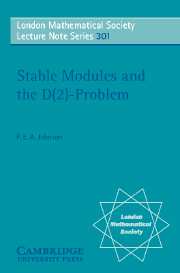Book contents
- Frontmatter
- Contents
- Acknowledgements
- Introduction
- 1 Orders in semisimple algebras
- 2 Representation theory of finite groups
- 3 Stable modules and cancellation theorems
- 4 Relative homological algebra
- 5 The derived category of a finite group
- 6 k-invariants
- 7 Groups of periodic cohomology
- 8 Algebraic homotopy theory
- 9 Stability theorems
- 10 The D(2)-problem
- 11 Poincaré 3-complexes
- Appendix A The D(2)-property for free groups
- Appendix B The Realization Theorem
- References
- Index
Introduction
Published online by Cambridge University Press: 04 August 2010
- Frontmatter
- Contents
- Acknowledgements
- Introduction
- 1 Orders in semisimple algebras
- 2 Representation theory of finite groups
- 3 Stable modules and cancellation theorems
- 4 Relative homological algebra
- 5 The derived category of a finite group
- 6 k-invariants
- 7 Groups of periodic cohomology
- 8 Algebraic homotopy theory
- 9 Stability theorems
- 10 The D(2)-problem
- 11 Poincaré 3-complexes
- Appendix A The D(2)-property for free groups
- Appendix B The Realization Theorem
- References
- Index
Summary
A history of the D(2)-problem
The problem with which this book is concerned arose from the attempt, during the 1960s, to classify compact manifolds by means of ‘surgery’ [7], [48], [71], [73]. Developing further the techniques of Thorn [64], Wallace [75], [76], [77], Milnor [43], and Smale [52], a movement led notably by W. Browder, S.P. Novikov, and C. T. C. Wall made a systematic effort to understand compact manifolds in terms of homotopy theory which, by that time, was already a mature subject, with its own highly developed literature and was considered, in practice, at least under the simplifying restriction of simple connectivity, to be effectively computable [8].
Wall's particular contribution to manifold theory was to consider surgery problems in which the fundamental group is non-trivial. Perhaps one should point out that by allowing all finitely presented fundamental groups, one automatically turns a computable theory into a noncomputable one [6], [47]. However, even if we restrict our attention to fundamental groups which are familiar, the extent to which the resulting theory is computable is problematic. It really depends upon what is meant by ‘familiar’, and how well one understands the group under consideration. When describing groups by means of generators and relations, there are easily stated questions which one can ask of very familiar and otherwise tractable finite groups which at present seem completely beyond our ability to answer.
In connection with this general attack, Wall wrote two papers which merit special attention. The first of these, ‘Poincaré Complexes I’ [72], gives general homotopical conditions which must be satisfied by any space before it can be transformed, by surgery, into a manifold.
Information
- Type
- Chapter
- Information
- Stable Modules and the D(2)-Problem , pp. 1 - 12Publisher: Cambridge University PressPrint publication year: 2003
